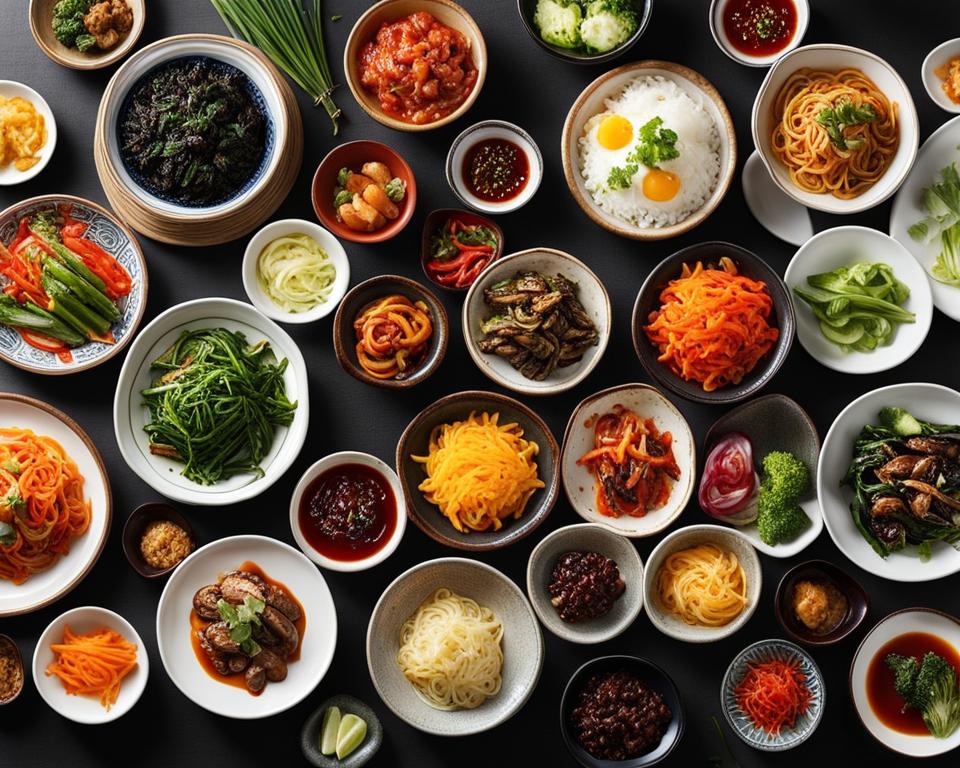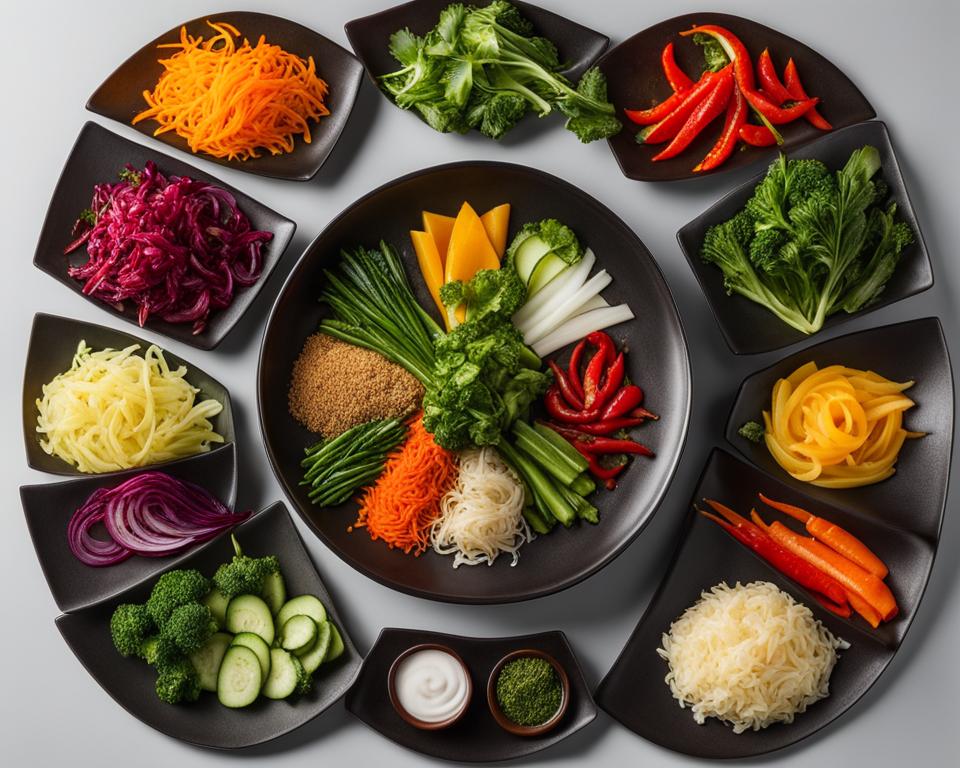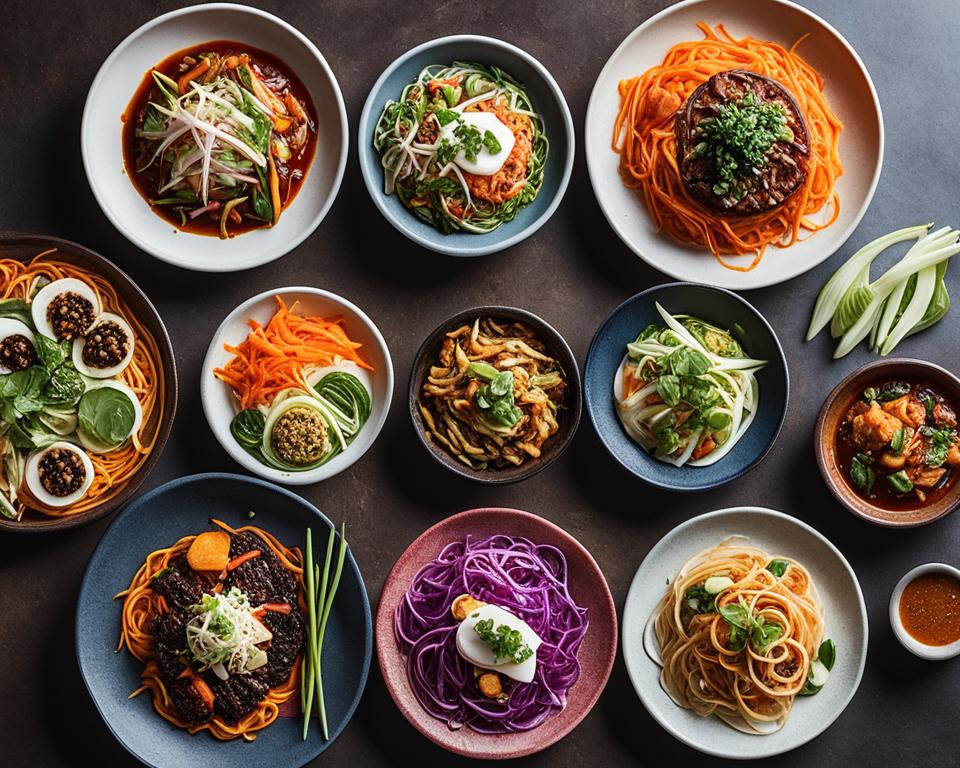Are you bored with the same old vegetarian side dishes? Look no further because we’ve got you covered with our savory Vegetarian Korean Side Dishes Guide. Korean cuisine is known for its bold flavors and unique spice blends, which makes it easy to create mouthwatering vegetarian dishes that are both healthy and delicious. In this guide, we’ll introduce you to a variety of traditional and easy-to-make Korean side dishes that are sure to impress. From quick and easy recipes to traditional and authentic options, we’ve got all your cravings covered. Discover how to bring the bold and flavorful taste of Korean cuisine into your kitchen with these healthy Korean vegetarian recipes.
With these recipes, you won’t have to sacrifice health for taste. Discover how to create vegetarian Korean side dishes that are packed with nutrients and flavor. These dishes are perfect for anyone looking for inspiration to add meatless options to their diet, or for vegetarians who want to explore the exciting world of Korean cuisine. Let’s get started on this flavorful and healthy adventure!
Quick and Easy Vegetarian Korean Side Dishes
Looking for easy korean vegetarian side dishes that require minimum effort? Look no further! Here are some quick vegetarian Korean recipes that you can prepare in just a few minutes.
If you’re a fan of kimchi, you can try making a simple cucumber kimchi that takes only a few minutes to prepare. Cut cucumbers into bite-sized pieces, add some garlic, ginger, chili flakes, salt, and sugar. Top it with vinegar and sesame oil, and your refreshing side dish is ready to go!
Another easy dish that you can make in a jiffy is stir-fried bean sprouts. Simply cook the bean sprouts in a pan with garlic, soy sauce, and sesame oil for a flavorful and crunchy addition to your meals.
And if you’re looking for something heartier, tofu stew is a great option. Boil some soft tofu in a spicy broth with mushrooms, onions, and other vegetables of your choice. Top it with an egg and some fresh herbs, and you have a comforting and satisfying dish in just a few minutes.
With these easy vegetarian Korean side dishes, you can add some Korean flavors to your meals without spending hours in the kitchen!
Traditional Vegetarian Korean Side Dishes
Experience the rich culinary heritage of Korea with these traditional vegetarian side dishes that are sure to delight your taste buds. Authentic Korean cuisine has long emphasized the use of plant-based ingredients in creating flavorful dishes that are both healthy and delicious.
One of the most popular traditional Korean vegetarian side dishes is Banchan, which are small dishes served with the main course. Banchan includes a variety of vegetables, often pickled or fermented, such as kimchi, seasoned bean sprouts, and spinach.
Another classic Korean vegetarian dish that has been enjoyed for centuries is Bibimbap, a rice bowl topped with various vegetables, fried egg, and spicy chili pepper paste. This dish is not only beautiful to look at but also packed with nutritious ingredients that make it a complete meal on its own.

For those looking for a heartier dish, Japchae is a stir-fried noodle dish that features a medley of vegetables and sweet potato noodles. It is a flavorful and filling dish that is perfect for satisfying your cravings on a chilly evening.
Recreating Authentic Korean Flavors in Your Kitchen
To create authentic Korean vegetarian side dishes at home, it’s important to use traditional Korean ingredients such as sesame oil, garlic, and soy sauce. These ingredients are essential in infusing dishes with the characteristic flavor profiles that are so synonymous with Korean cuisine.
By following these traditional recipes and incorporating authentic ingredients, you can create a truly authentic Korean dining experience right in the comfort of your own home.
Flavorful and Healthy Korean Vegetarian Recipes
If you’re looking for dishes that are both healthy and full of flavor, try your hand at these delicious Korean vegetarian recipes. From tofu stir-fry to vegetable-packed bibimbap, these dishes are sure to become your go-to meals for nourishing your body and satisfying your taste buds.
Nutrient-Packed Vegetable Japchae
Japchae is a classic Korean dish that features glass noodles made from sweet potato starch. This recipe is packed with vegetables like shiitake mushrooms, bell peppers, and spinach, ensuring you get plenty of nutrients with every bite. The addition of tofu provides a protein boost, making this dish a complete meal in itself. Make a large batch, and you’ll have leftovers for days.
Protein-Rich Tofu Bulgogi
Bulgogi is a popular Korean dish made with marinated beef, but this recipe uses tofu as a vegetarian-friendly alternative. The tofu is marinated in a sweet and savory sauce made from soy sauce, sugar, and garlic. Serve it over rice or with a side of steamed vegetables for a satisfying meal that is both healthy and delicious.
Vibrant and Fresh Bibimbap
Bibimbap is a Korean dish that translates to “mixed rice.” It is typically served in a bowl with rice, vegetables, and meat, topped with a fried egg and spicy sauce. This vegetarian version swaps the meat for colorful and fresh veggies like carrots, spinach, and bean sprouts. Top it with a fried egg and hot sauce for a flavorful and satisfying meal.
Try these recipes and experience the depth and complexity of Korean flavors in a vegetarian context that doesn’t compromise on taste or nutrition.
Delicious Korean Vegetarian Side Dishes to Try
Bring a taste of Korea to your table with these delicious and popular vegetarian Korean side dishes. One of the most beloved is kimchi, a tangy and spicy dish made with fermented cabbage and spicy chili paste. Another classic is japchae, a stir-fried noodle dish made with sweet potato noodles, vegetables, and soy sauce. For a crispy and flavorful rendition, try haemul pajeon, a savory pancake made with green onions and seafood. And for a healthy and satisfying option, go for dubu jorim, a braised tofu dish seasoned with soy sauce, garlic, and green onions.

These are just a few examples of the mouth-watering vegetarian Korean side dishes waiting to be discovered. Whether you’re a vegetarian or simply looking to add more healthy and flavorful options to your diet, these dishes are sure to satisfy your cravings.
Exploring the Exciting World of Vegetarian Korean Cuisine
If you’re curious about the world of Vegetarian Korean cuisine, then you’re in for a treat. Korean cuisine is known for its bold flavor combinations incorporating savory, sweet, sour, and spicy elements. It’s no surprise that Korean cuisine has captured the attention of food enthusiasts worldwide—including vegetarians.
Vegetarian Korean side dishes are packed with the unique flavors and spices of Korean cuisine while incorporating healthy plant-based proteins, such as tofu, mushrooms, and legumes.
To truly comprehend the flavors and techniques of Korean cuisine, understanding the key ingredients is necessary. For instance, kimchi, a fermented cabbage dish, is a staple in Korean cuisine that adds a burst of spicy and sour flavors to any dish. Sesame oil, another staple ingredient, is used to add toasty flavor nuances to dishes such as stir-fries and side dishes.
Other important seasonings in Vegetarian Korean cuisine include soy sauce, red pepper flakes, garlic, ginger, and scallions. Understanding these flavors and spices’ unique roles will help you achieve the depth of flavors that make Korean side dishes truly outstanding.
One iconic Vegetarian Korean side dish is Japchae, a stir-fried noodle dish made with sweet potato noodles and a colorful blend of vegetables, such as spinach, carrots, and mushrooms. The dish is seasoned with a sweet and savory soy sauce-based sauce and garnished with sesame seeds.
Exploring Vegetarian Korean cuisine is a great way to expand your culinary repertoire and introduce new and exciting flavors to your meals.
Tips and Tricks for Perfect Vegetarian Korean Side Dishes
Creating the perfect vegetarian Korean side dish can seem daunting, but with the right tips and tricks, you’re sure to impress with your culinary skills. Here are some useful pointers that will elevate your vegetarian Korean side dishes to the next level:
Experiment with Ingredient Substitutions
Not everyone has access to traditional Korean ingredients, but fear not. Experiment with ingredient substitutions to achieve a similar flavor profile. For example, try substituting soy sauce with tamari or using agave nectar instead of honey. The possibilities are endless.
Master Preparation Techniques
Perfecting the preparation techniques is just as important as having the right ingredients. To enhance the flavor of your ingredients, try marinating them for a few hours before cooking or stir frying vegetables to lock in nutrients and flavors.
Presentation is Key
The visual appeal of a dish can make all the difference in the world, so don’t overlook the importance of presentation. Use bright, vibrant colors and arrange your ingredients in an aesthetically pleasing way. Add a sprinkle of sesame seeds or sliced green onions as a finishing touch to make your dish look even more appetizing.
By following these tips and tricks, you’re sure to create perfect vegetarian Korean side dishes that are not only delicious, but also pleasing to the eye.
A Selection of Must-Try Vegetarian Korean Recipes
Looking to expand your vegetarian Korean cooking repertoire? Look no further than these handpicked must-try recipes featuring bold flavors and unique ingredients.
Spicy Tofu Stew
This hearty stew is packed with protein and a spicy kick that will keep you warm on chilly nights. Featuring cubes of soft tofu, crunchy veggies, and a savory broth, this dish is sure to become a favorite.
Korean-Style Fried Rice
Combing bold flavors with comforting carbs, this fried rice recipe is a must-try for any Korean cuisine enthusiast. Featuring fluffy rice, marinated tofu, and plenty of aromatic veggies, this dish is both satisfying and nutritious.
Zucchini Pancakes
Crispy and comforting, these zucchini pancakes are a staple of vegetarian Korean cuisine. Made with grated zucchini, flour, and a variety of spices, these pancakes are a perfect snack or side dish.
With these delicious and unique vegetarian Korean recipes, you’ll have plenty of options for exploring this exciting cuisine. Whether you’re a long-time vegetarian or simply looking to add more meatless options to your diet, these recipes are sure to impress.
Exploring Korean Cuisine for Vegetarians
For vegetarians, exploring Korean cuisine opens up a world of diverse and flavorful options. Vegetarian Korean side dishes, in particular, demonstrate the creativity and adaptability of the cuisine to a meat-free lifestyle.
One of the main ingredients in Korean cuisine is gochujang, a red chili paste that adds depth and spice to dishes. It is important to note that not all gochujang pastes are vegetarian, so it’s crucial to read the label or make it from scratch at home. Other common vegetarian-friendly ingredients in Korean cuisine include soy sauce, tofu, rice, and a variety of vegetables such as cabbage, spinach, and bean sprouts.

Cooking methods employed in Korean cuisine are typically healthy, with a focus on stir-fry, grilling, and braising. This style of cooking lends itself perfectly to vegetarian options and allows for flavorful combinations that are both satisfying and healthy.
Flavor profiles in Korean cuisine are also diverse, ranging from spicy and tangy to savory and sweet. Vegetarians can enjoy classic dishes such as kimchi and japchae, as well as lesser-known but equally delicious side dishes like kongnamul muchim (seasoned soybean sprouts) and nokdujeon (mung bean pancakes).
Overall, exploring Korean cuisine for vegetarians can provide a wealth of exciting options for meals and snacks. With its diverse ingredients, healthy cooking methods, and innovative flavor combinations, there’s no doubt that Korean cuisine is a must-try for vegetarians looking to broaden their culinary horizons.
Bringing Korean Flavors into Your Vegetarian Kitchen
Are you a big fan of vegetarian Korean side dishes and want to bring those flavors into your own kitchen? It’s easier than you might think!
One simple way to add a touch of Korean influence to your dishes is by incorporating common Korean ingredients, such as gochujang (red chili paste), soy sauce, sesame oil, and garlic, into your recipes. These ingredients can be found at most grocery stores and can be added to a wide range of dishes to give them a unique and delicious flavor.
If you’re feeling adventurous, you can also experiment with traditional Korean cooking techniques, such as stir-frying, grilling, and braising, to add depth and complexity to your dishes.
Another way to introduce Korean flavors to your vegetarian cooking is by trying out Korean-inspired vegetarian recipes. Explore a range of vegetarian Korean side dishes, mains, and snacks, and find the recipes that best suit your taste preferences.
Don’t be afraid to get creative with your cooking and try new things. By incorporating Korean flavors into your vegetarian kitchen, you’ll be adding a unique and exciting twist to your meals while satisfying your taste buds.
What are some of your go-to vegetarian Korean side dishes? Share your favorites in the comments below!
SEO keywords: vegetarian korean side dishes
FAQ
What are some easy vegetarian Korean side dishes?
Some easy vegetarian Korean side dishes include seasoned seaweed (gim), stir-fried tofu (Dubu-bokkeum), and steamed eggplant (Gaji-namul). These dishes can be prepared quickly and are packed with delicious flavors.
Are vegetarian Korean side dishes healthy?
Yes, vegetarian Korean side dishes can be healthy as they often feature a variety of vegetables and plant-based proteins. These dishes are typically low in saturated fats and high in nutrients, making them a nutritious addition to your meals.
What are some traditional vegetarian Korean side dishes?
Traditional vegetarian Korean side dishes include kimchi, a spicy fermented cabbage dish, and Japchae, a stir-fried glass noodle dish with vegetables. Other traditional options include seasoned bean sprouts (Kongnamul-muchim) and spicy cucumber salad (Oi-muchim).
How can I make vegetarian Korean dishes flavorful?
To make vegetarian Korean dishes flavorful, it’s important to use ingredients like soy sauce, sesame oil, garlic, ginger, and Korean chili paste (gochujang). These ingredients add depth and umami to the dishes, creating a rich and satisfying flavor profile.
Which vegetarian Korean side dishes are popular among food enthusiasts?
Popular vegetarian Korean side dishes include Korean pancakes (Jeon), spicy radish salad (Musaengchae), and soybean sprout soup (Kongnamul-guk). These dishes are loved for their unique flavors and textures and are often enjoyed as part of a larger Korean meal.
Can I substitute ingredients in vegetarian Korean side dishes?
Yes, you can substitute ingredients in vegetarian Korean side dishes based on your preferences or dietary restrictions. For example, if a recipe calls for tofu but you prefer tempeh, you can easily swap them out. Just keep in mind that the flavor and texture may vary slightly.
How can I perfect my vegetarian Korean side dishes?
To perfect your vegetarian Korean side dishes, practice is key. Experiment with different combinations of ingredients and seasonings to find your preferred taste. Pay attention to cooking techniques and ensure vegetables are cooked to the right level of tenderness for optimal flavor and texture.
What are some must-try vegetarian Korean recipes?
Some must-try vegetarian Korean recipes include bibimbap (mixed rice dish), doenjang jjigae (soybean paste stew), and kimchi jjigae (kimchi stew). These dishes showcase the variety and complexity of flavors in Korean cuisine and are enjoyed by vegetarians and non-vegetarians alike.
How can I incorporate Korean flavors into my vegetarian dishes?
You can incorporate Korean flavors into your vegetarian dishes by using ingredients like gochujang (Korean chili paste), sesame oil, and soy sauce. Additionally, try incorporating Korean spices and seasonings, such as garlic, ginger, and scallions, to enhance the overall flavor profile.